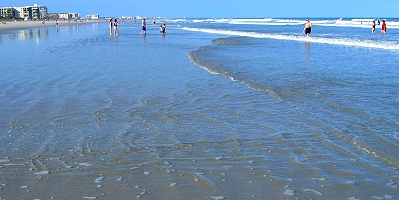
Life’s a beach. In Florida that little pun takes on some real meaning.
Of The Sunshine State’s twelve hundred miles of coastline, over half is covered by beautiful sandy beaches.

We are big fans of the seashore, so much so that we spent almost a decade on a secluded Caribbean island, so we were beside ourselves with excitement to get back to the beach.
Our usual beach activity consists of walking along for miles right where the surf meets the sand, but we discovered something new and different along Florida’s east coast, biking on the beach. Makes it a lot easier to bring our favorite Snack for Beaches too.

In many places the sand is packed down hard enough so that not just bicycles, but cars, and even RVs can cruise along the beach.
Cars used to race along these sandy strips, that’s how auto racing in Daytona got its start.
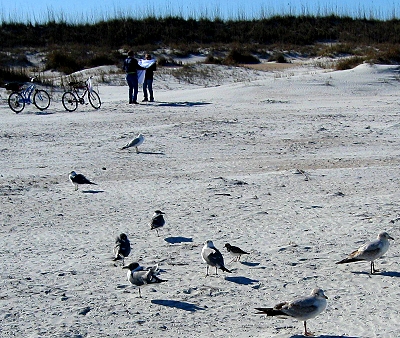
We weren’t ready for any five hundred mile speed competitions, but we were pretty jazzed about riding our trusty bikes right along the ocean.
We rode several miles until we came upon one of many common inhabitants of the Florida beaches, a beach bar.
It didn’t take us long to figure out that we were never very far from the nearest Sand Bar, Pirate’s Cove, Sand Dollar, Barnacle Bill’s, Down The Hatch, Hurricane Hole, or this particular day’s pitstop, Beachcomber.
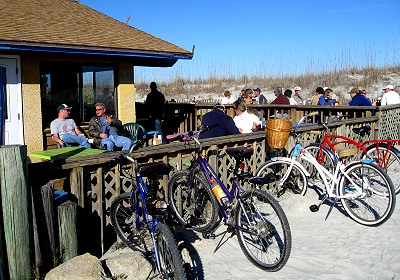
One thing about beach bars, they are not really night spots. A good beach bar gets crackin’ in the afternoon and peaks right at sunset, so our timing was good.
We hit right when the local beach bums were hitting their strides, so we ordered up some fish and a cold one, and got the full scoop on all the ins and outs of life at The Beachcomber. The old salts and fisherfolk always seem ready to spin a yarn, or maybe even sing a shanty.
Ears and bellies filled, we put our tires to the sand again and pedaled back to town. Town at this point of our journey meant St. Augustine. It was there that we were introduced to a game that we had never come across before, but would many times again in our travels down the coast, Pétanque.

Noticing some men playing the game in the sandy parking lot of a little cafe, we thought it might be Bacci Ball, a pastime we had seen quite often in our travels in Italy.
While Pétanque, pronounced pay-tonk, is similar, it has the advantage of being playable almost anywhere. Any reasonably smooth open area will suffice.
Intrigued, we dismounted and stopped to watch a while. When the players noticed that they had spectators, the members of the Boules de León Pétanque Club were very gracious in explaining the game to us.
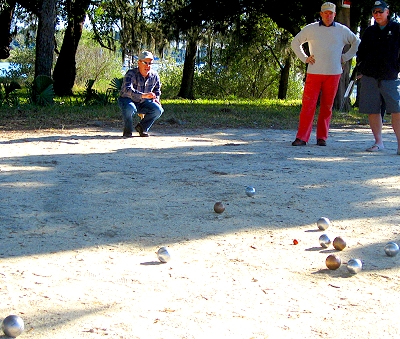
A small ball called a cochonnet (French for piglet) is thrown out and becomes the target. Larger, and heavy, metal balls are tossed at the piglet and the score depends on who gets the closest. If a player is skilled enough to actually touch the cochonnet, he has “kissed the pig.”
After our lesson, we were invited to have a go. We jumped right in and, though our happily competitive selves had a new way to pit our talents against each other, our skills were erratic at best.
Sometimes the poor little piglet was in danger of being crushed, while others there wasn’t a steel ball anywhere near the baby porker. Pétanque, it seems, is one of those games that is easy to learn but difficult to master.
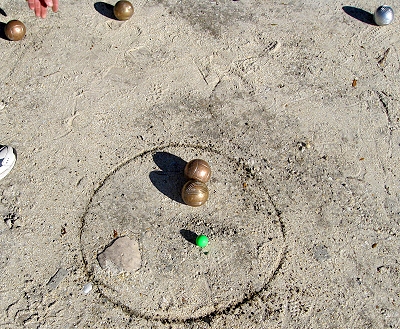
Pétanque is an offshoot of lawn bowling, or boules in French, that became popular along the Riviera about one hundred years ago.
That popularity seems to have spread to Quebec, and then down to Florida with the snowbirds. Once we were aware of it, we began to notice it everywhere.
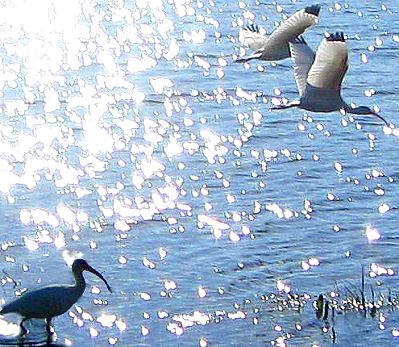
This wasn’t the only surprise we were in for. A little way down the coast we had several close encounters, but not of the third kind, of the bird kind. (ba-da-ching).
The first couple, while not technically on the beach, were right by the ocean.
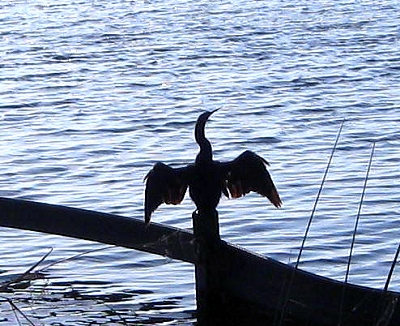
Riding along the trails in Chain of Lakes Park, between the towns of Mims and Titusville, we saw several Anhinga.
These skilled fish finders majestically dry their wings in the sun by almost every body of water. When they dive they go completely under water to chase their prey, so afterward their feathers must be dried before any flying can be done.
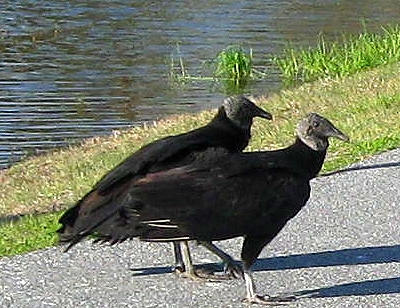
Farther up the trail we came upon a massive flock of giant black birds.
At first it was hard to tell what sort of birds they were, but as we got a closer look it became clear that they were vultures. Hundreds of buzzards!
They were in the trees, in the air, and all over the ground, just waiting for something, or someone, to kick the bucket so they could chow down.
Maybe we’ve seen too many cartoons and old Westerns, but it was seriously disturbing to be constantly eyed by these hunched over, winged scavengers.

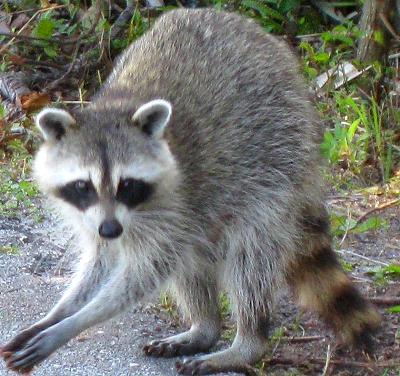
Another encounter came when we heard rustling in the brush while we were walking from the parking lot to the beach at Cocoa Beach.
Next thing we knew a bunch of furry little masked bandits burst out of the bushes like The Great Train Robbery.

This struck us as odd since we weren’t carrying any valuables and were right in the middle of town.
These guys were not the least bit disturbed with the presence of people. Uncomfortably so.
Raccoons are one of the few animals that have not only adapted to living among humans, but actually thrive on it. People seem to inadvertently provide a great deal of food for these resourceful little critters.
We were completely taken in by their ridiculous cuteness and hung around for quite a while watching and taking pictures. But the quest for an encounter with another Florida creature was on our minds.
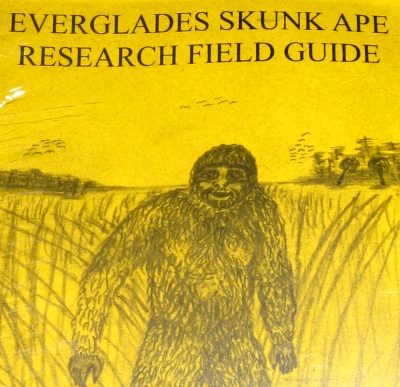
We had heard tell of a legend that a great beast has been making his home in the everglades, no, not a giant gator (although there are plenty of them down there), the skunk ape. How can we possibly resist searching for this elusive cousin of bigfoot?
The answer is – we can’t. Stay tuned…we’ll be posting soon, if we make it out alive.
David & Veronica, GypsyNester.com
This post may contain sponsored links.



As many New Yorkers that go to Florida every year and eventually settle I have never been to these beaches. I feel a trip down there when the weather turns cold in the Northeast this year.
That’s nice the Pétanque players gave you a little lesson and introduction into their sport.
Love the birds!
Life is a Beach and while you at the beach consider reading Beach Chair Diaries Summer Tales from Maine to Maui
It all sounds fun. One of our “spawn” (to borrow a Gypsy Nester term) moved to South Beach (Miami), which, in the winter, is a lot nicer than “Down tha’ Shore”—southern New Jersey beaches to Philadelphians. We even bought a house on one of the New Jersey barrier islands–perhaps not the wisest investment as the planet warms.
Are the northeast Floridians guarding the habitats of the creatures that nest and feed on the beach there? Sounds like there’s a lot of traffic on the sand.
There are protected areas but a lot of habitat is being or has been developed. Florida doesn’t have a great track record when it comes to wildlife protection but they are working on the everglades now.